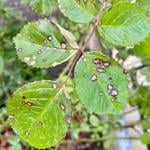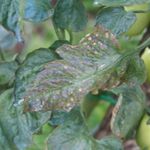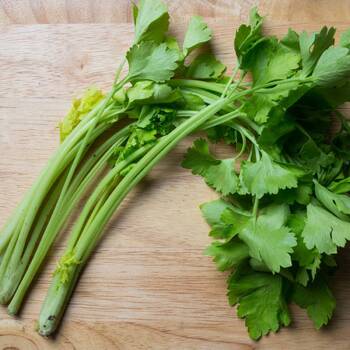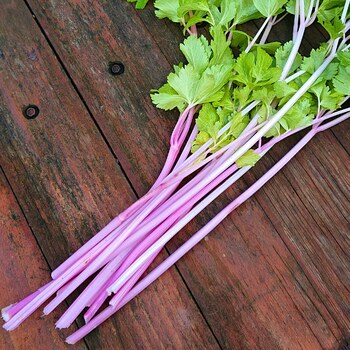
How to Grow Celery Seeds
Grow Guide #2247
Family: Apiaceae
Binomial name: Apium graveolens
Life Cycle: Biennial (usually grown as an annual)
This 'How to Grow' guide details everything a home gardener needs to know to plant, grow and care for Celery (Apium graveolens).
Most varieties of celery are grown for their edible stalks. Leaf celery is grown in the same way as celery but the leaves are eaten instead of the stalks. Celeriac is the same species as celery but is grown as a root vegetable.
When to Sow Celery Seeds
Celery can be grown year-round in most climates. Avoid planting in extremely hot or cold weather which can affect germination and growth. Use the table below to identify the best time of year to sow celery in your climate.
| JAN | FEB | MAR | APR | MAY | JUN | JUL | AUG | SEP | OCT | NOV | DEC | |
|---|---|---|---|---|---|---|---|---|---|---|---|---|
| Cool | ||||||||||||
| Temperate | ||||||||||||
| Sub-Tropical | ||||||||||||
| Tropical | ||||||||||||
| Arid |
Preparation
Celery plants are best grown in full sun or part shade. Choose a location that will receive at least 3 hours of full sun each day.
Celery plants need a well drained soil enriched with plenty of organic matter. Prepare soil by weeding it thoroughly, digging it over to loosen it and adding aged animal manure or compost. Keep the area free of weeds until planting. Learn more about preparing soil for planting here.
Celery plants can be grown in containers. If possible choose a variety that’s recommended for container growing. Use a good quality potting mix and make sure your container is large enough for mature plants; a minimum of 20 litres is recommended for celery. During the growing season, keep in mind that container grown plants may need additional fertiliser to encourage healthy growth.
How to Sow Celery Seeds
Celery seeds do not require any treatment (eg soaking, stratification) before sowing.
Celery seeds grow best when they are raised in trays or other containers and transplanted to the garden once established.
- Fill trays, punnets or jiffy pots with a good quality seed-raising mix, or use soil starter pellets.
- Sow seeds 3mm deep.
- Keep soil moist but never wet or dry.
- Seeds should germinate in around 14-21 days at a soil temperature of 21-25°C.
- Transplant seedlings to the garden once they have their first true leaves and are large enough to handle (usually 5-10cm tall).
- Plant out, spacing plants 20-30cm apart, with rows 30-55cm apart.
Celery may bolt if seedlings are exposed to cool weather. Do not transplant seedlings or sow seeds outside in very cool temperatures.
Tip: Celery seeds are quite small. Handle them carefully to avoid them blowing away or being washed away. Mix seeds with sand or fine potting mix prior to sowing or use a seed dispenser, damp toothpick or tweezers to help space them evenly. Press lightly into the surface after sowing so that the seeds make good contact with the soil. Take extra care to make sure seeds and seedlings don’t dry out. Read more about sowing small seeds here.
How to Grow Celery
Celery plants need regular watering during the growing season. Do not let soil dry out; keep soil evenly moist but not waterlogged. Water deeply in the early morning or late afternoon. Avoid watering the leaves of plants to avoid fungal diseases. Learn more about watering here.
If soil was well prepared no extra fertiliser should be necessary. In poor soil or to give your plants an extra boost, application of a balanced fertiliser or one formulated for fruit and vegetables can be beneficial:
- Apply slow release fertiliser at the recommended rate when transplanting or when seedlings are 5-10cm tall.
- Apply liquid fertiliser at the recommended rate and frequency while plants are fruiting or flowering.
Celery plants can be blanched to improve tenderness and flavour. Exclude light around plants by hilling soil up around their bases, mulching thickly with straw or placing opaque containers around the plant. Learn more about blanching here.
How to Harvest Celery
Celery should be ready to harvest in approximately 120-140 days.
Celery stems are ready to harvest when they are large enough to eat. Harvest the outside stems first, leaving some in the centre of the plant for future growth. Harvest individual stems by pulling and twisting them gently from the base to separate them from the plant. Harvest whole plants by cutting them at ground level.
Celery is best eaten soon after it is harvested. Celery can be stored short term in a perforated plastic bag in the fridge.
Leaf celery only - Harvest the stalks and leaves as needed, cutting the leaves to separate them from the stalks. The stalks can be eaten but are usually discarded as they are fibrous. Leaf celery is best eaten soon after it is harvested. Leaf celery can be stored short term in a perforated bag in the fridge. Leaves can also be dried for long term storage.
Common Problems when Growing Celery
Like all plants, celery is susceptible to some pests, diseases and other problems. Below is a list of the most common problems gardeners encounter when growing celery plants:
 Bacterial leaf spot is a disease that causes irregularly shaped brown spots on all above-ground parts of a plant. The spots at first appear to be wet but become dry and scab-like over time. Leaves and flowers can fall prematurely. Water plants at soil level (not on the leaves), dispose of fallen leaves and fruit and practice crop rotation.
Bacterial leaf spot is a disease that causes irregularly shaped brown spots on all above-ground parts of a plant. The spots at first appear to be wet but become dry and scab-like over time. Leaves and flowers can fall prematurely. Water plants at soil level (not on the leaves), dispose of fallen leaves and fruit and practice crop rotation. Bitter taste can be caused by plants growing too slowly, suffering a setback in growth or being harvested too late. Enrich soil with aged manure before planting, ensure plants are watered deeply and regularly, and harvest when they are young and tender.
Bitter taste can be caused by plants growing too slowly, suffering a setback in growth or being harvested too late. Enrich soil with aged manure before planting, ensure plants are watered deeply and regularly, and harvest when they are young and tender. Bolting is when a plant prematurely flowers and goes to seed. Bolting can be caused by a period of extreme weather. Avoid sowing seed until after the danger of frosts has passed or in very hot weather. Water plants regularly and deeply in hot weather to prevent them suffering heat stress.
Bolting is when a plant prematurely flowers and goes to seed. Bolting can be caused by a period of extreme weather. Avoid sowing seed until after the danger of frosts has passed or in very hot weather. Water plants regularly and deeply in hot weather to prevent them suffering heat stress. Damping off is caused by a fungal growth that transfers from the soil to seeds or tender seedlings. Seeds may appear not to germinate, or young plants start to rot when they emerge from the soil and become soft and mushy at the base before dying. Use new potting mix if raising seedlings, do not water foliage and avoid waterlogged soil. Read more about damping off here.
Damping off is caused by a fungal growth that transfers from the soil to seeds or tender seedlings. Seeds may appear not to germinate, or young plants start to rot when they emerge from the soil and become soft and mushy at the base before dying. Use new potting mix if raising seedlings, do not water foliage and avoid waterlogged soil. Read more about damping off here. Downy mildew is a fungal disease that causes yellow to grey-brown patches on leaves, especially the undersides. Water plants at soil level (not on the leaves), remove and destroy affected leaves and do not overcrowd plants to ensure adequate air flow. If problems persist, spray with a homemade milk spray or fungicide.
Downy mildew is a fungal disease that causes yellow to grey-brown patches on leaves, especially the undersides. Water plants at soil level (not on the leaves), remove and destroy affected leaves and do not overcrowd plants to ensure adequate air flow. If problems persist, spray with a homemade milk spray or fungicide. Slugs and snails are molluscs that feed on tender leaves and shoots, mostly at night, leaving slimy trails behind them. Control them by removing their hiding places, keeping free range poultry, collecting them by torchlight or by placing traps. Read more about slugs and snails here.
Slugs and snails are molluscs that feed on tender leaves and shoots, mostly at night, leaving slimy trails behind them. Control them by removing their hiding places, keeping free range poultry, collecting them by torchlight or by placing traps. Read more about slugs and snails here.


.png)






